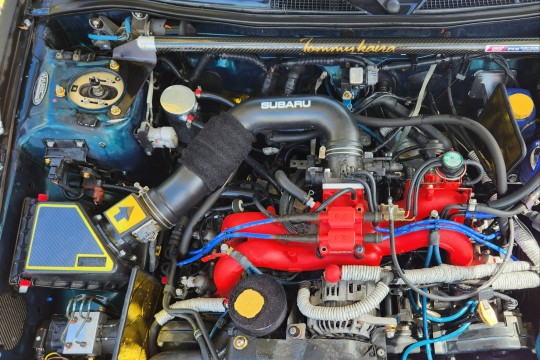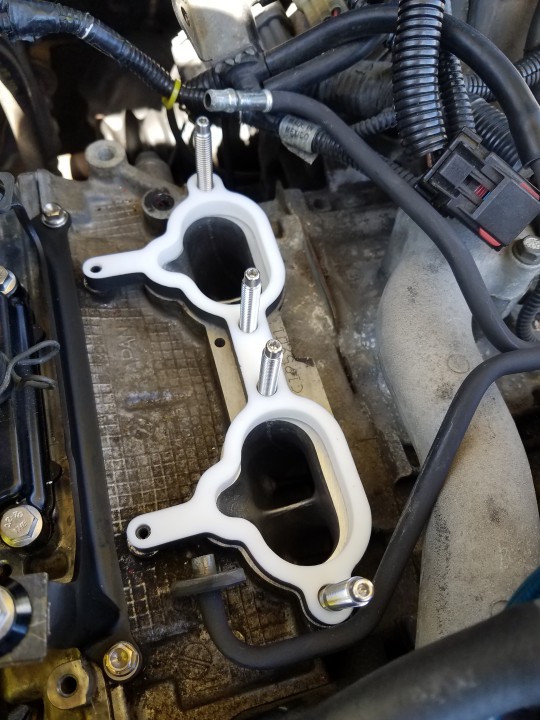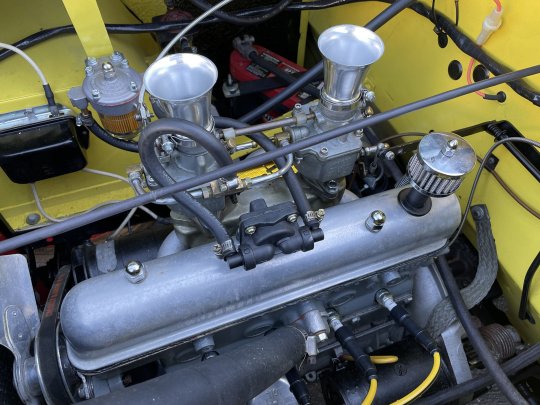#Intake Manifolds Market
Photo










Borgward Isabella Coupé
Has any automaker gone from oblivion to success and back again as quickly as Borgward? Mention the name today, and you're likely to get blank stares, or questions along the lines of "Borgward? Who made those?" It's hard to imagine any European posing that sort of question in 1955, when Borgward had risen from the post-war rubble to outsell all other German automakers but Volkswagen, or 1958, when the Bremen firm very nearly nipped Porsche for the German sports-car championship. And yet, by 1962, the company was gone, the victim of a tragic and avoidable series of circumstances.
The Isabella was a bull's-eye in the mid-priced sedan market segment. Volkswagens were less expensive, but smaller and less powerful. Mercedes-Benz's 180 sedan had the sophistication of an overhead cam, but no greater top speed, and cost 30 percent more than the Isabella's list price of 7,265 Deutsche Marks. Opel's Olympia Rekord couldn't touch its top speed, or its all-coil-sprung suspension; and BMW had nothing between the fantastically expensive "Baroque Angel" 501 and the Isetta-based 600 microcar. On top of it all, the press loved the car. By the end of 1954, more than 10,000 Isabellas had rolled out the factory gates.
The Isabella had thoroughly up-to-date underpinnings, with a coil spring at each corner, swing axles in the rear and A-arms up front. The engine, a pushrod four designed by Karl Ludwig Brandt, wrung 75hp from its 1,493cc, with its relatively high 8.2:1 compression ratio and good breathing. The intake manifold was entirely enclosed atop the engine, making for a tidy design that could have been mistaken for an OHC. So sound was the engine that, developed for racing, it powered Cooper-Borgwards to many Formula 2 victories in the Fifties. The Borgward RS, or Rennsport, became Porsche's nemesis in the hands of drivers like Stirling Moss, Jo Bonnier and Hans Herrmann.
If the Isabella had a flaw, it was that its development had been limited, and early cars suffered from weak engine bearings and front-end components. Competitors started a whispering campaign about "die Traumfrau mit der schmutzigen Unterwäsche," or "the dream girl with the dirty underwear," but Borgward, unfazed, worked with its suppliers to iron out the bugs, and no real harm was done to the model's reputation.
Just as with the Hansa 1500, new models were quickly spun off the Isabella. In 1955, Borgward launched convertible and station wagon versions, as well as a hot TS ("Touring Sport") model with a two-barrel carburetor that could top 90 MPH, leaving Porsche 1300s behind. As the decade wore on, new designs from its competitors and a softening economic situation led to declining sales, prompting Carl F. W. to add the most glamorous model yet to the Isabella lineup: the Coupé.
72 notes
·
View notes
Text

Since there has been some interest in my current intake, here is it broke down. I have tried numerous setups but this custom OEM+ version is the best and passes stupid SMOG visual check.
I also intensely studied the 2.5RS forums and looked at dyno charts showing that this IS the best when combined with a 2.25" cat back exhaust and equal length headers. Trust me!
This was a lot work as well as trial and error and willingness to start over again and redo it again several times. I think this was also the lightest combo if you trying to reduce weight.
One of a kind custom intake for the naturally aspirated Subaru EJ25D....

First up is you need the intake tract/duct and hoses from an earlier model Subaru Impreza or any Subaru that has this intake tube vs the stock version with the "torque box" behind the throttle body. Junkyard is your best buddy.
I had expensive high performance mandrel bent blah blah blah intakes which I constantly struggled with keeping the metal tubing cool (I used a laser temp gauge). This plastic is basically the same but rarely gets too hot to touch. So, actually a cold air intake if you keep reading.

Since the entire manifold needed to come out, I painted it wrinkle red and polished the runners and throttle inlet.

The reason I removed the manifold was to install stainless studs to make installing the 10mm thick teflon spacers and 2 sets of gaskets easier. Similar to 8mm Grimmspeed phenolic (previously installed) but thicker. This mod makes a big difference, the entire manifold now stays cool. No more engine block heat soak, only ambient engine bay heat.
"For every 5 degree reduction in temperature, increases power by 1%"
You have to extend the EGR tube and possibly grind your ignition coil pack mounts lower. Because the entire manifold assembly will be sitting ~12mm higher.

I was fortunate enough to work with the gasket maker. So he made 10mm teflon intake manifold spacers and a matching prototype 10mm throttle body spacer! Again 2 gaskets to ensure no leaks. Not sure if these were ever made available afterwards since I was the first car.
This spacer combo increased plenum volume as well as helped to keep heat transfer drastically reduced.

Using my custom ported, polished and knife edged throttle body that I did myself with the coolant hose permanently bypassed and the cruise control bits removed. Keep in mind you will need longer bolts if you use a spacer here. Definitely improved throttle response after just the throttle body swap.

I scored this GC8 v3 factory resonator/cold air intake inlet from the UK. It's what goes with those fender plugs. Grabs cold air from inside the fender behind the corner light up high, so no chance of sucking up water. FWIW, You really shouldn't just delete the "snorkus", seriously, it's just gonna mess up your MAF sensor.
I was also able to make the resonator from a SVX work in the 04 Outback with some persuasion. It too takes air from the same location but the box was hard to cram in the fender.

The intake tract will work with whatever air filter box but in order to use the EUDM WRX intake inlet/resonator you will need the matching filter housing box from an earlier model or have to drill a new mounting hole. You will need both halves!

BEST panel filter on the market IS made by Grimmspeed! Don't waste your money on any other filter! I also added a Filter Wears waterproof inlet cover/pre-filter to the resonator just incase of water spray. The factory option fender plug fills that hole.

And I'm not sure if this was an upgrade or not but here is the JDM JECS MAF I am also using. Used DEI gold heat reflective tape to keep it cool and extend the life. Possibly more consistent/accurate readings?
The only other things installed are a Weapon R catch can to the PVC, which DOES keep some crap out of the intake tract and off the throttle body but probably no real performance advantage. Plus a heat/flame resistant "sock", same as around my fluid reservoirs, over the bendy/flexible bit of the intake tract just after the MAF. That area is prone to splitting/cracking with heat and age!
Now for treasure at the end of the rainbow! I am actually gonna give you nerds the mother fucking part numbers! These can be life savers when searching for parts.
*You might have to make or reuse your PVC, crankcase, IAC valve hoses. So grab whatever is attached if your at the junkyard or hit up the auto parts store.
•Subaru PN's:
Intake duct/tract (EJ22): 14457AA111
Air filter housing/box: A53FA02 (upper) & A53FA01 (lower)
Fender resonator/snorkus (UK WRX): A21FA03 or A32FA01 or A21FA00
Fender plug: 46059FA000
•Grimmspeed PN's:
Dry-Con Air Filter: 060092
Intake manifold spacers (8mm phenolic): 015001
#subaru#custom#intake#mods#how to#diy#fyi#upgrades#naturally aspirated#ej25d#90s japanese cars#impreza#legacy gt#forester#my car#mecha gt#cold air intake#car parts#part numbers#oem+#the more you know#knowledge#tutorial#hp gains#boxer engine#subie#subienation#modified cars#2nd gen#bk6
19 notes
·
View notes
Text
0 notes
Text
Sugar Defender
The Modern Sugar Crisis
In today's fast-paced world, sugar has stealthily woven itself into the fabric of our daily diets. From the obvious sweet treats to the unexpected culprits like savory snacks and sauces, sugar is omnipresent. The modern sugar crisis isn't merely about the visible sugar cubes in your morning coffee but the hidden sugars lurking in processed foods. This pervasive presence has precipitated a health epidemic, one that necessitates immediate attention and action.
Purpose of the Sugar Defender
The Sugar Defender initiative seeks to arm individuals with the knowledge and tools needed to reclaim their health from the clutches of sugar. It is a clarion call to understand, mitigate, and eventually conquer the adverse effects of excessive sugar consumption.

The Hidden Dangers of Sugar
Sugar’s Pervasive Presence in Diets
One of the most insidious aspects of sugar is its pervasive presence in our diets. It's not just in desserts and sweets but in bread, pasta sauces, and even salad dressings. This ubiquity makes it challenging to avoid and easy to overconsume.
Health Risks Associated with Excessive Sugar Consumption
The health risks linked to excessive sugar intake are manifold. From obesity to heart disease, diabetes to liver conditions, sugar is a major contributor to many chronic ailments. Its role in these diseases often goes underestimated, overshadowed by more visible dietary culprits.
The Addictive Nature of Sugar
Sugar's impact on the brain mirrors that of addictive substances. It stimulates the release of dopamine, creating a cycle of craving and consumption. This addictive nature makes it difficult for individuals to reduce their intake, perpetuating health problems.
Understanding Sugar Types
Natural vs. Added Sugars
Natural sugars, found in fruits and vegetables, come with fiber, vitamins, and minerals that mitigate their impact on health. Added sugars, however, are introduced during processing and offer no nutritional benefits, contributing solely to calorie intake.

Refined Sugars and Their Impact
Refined sugars, such as white and brown sugar, undergo extensive processing, stripping them of any residual nutrients. Their high glycemic index causes rapid spikes in blood sugar levels, leading to insulin resistance and other metabolic disorders.
The Role of Artificial Sweeteners
Artificial sweeteners are marketed as a healthier alternative to sugar, but their long-term health effects remain controversial. While they may help reduce calorie intake, they can disrupt metabolic processes and gut microbiota, posing their own set of health risks.
Sugar and Metabolic Health
How Sugar Affects Metabolism
Excessive sugar intake disrupts metabolic processes, leading to fat accumulation and weight gain. It impairs the body's ability to regulate blood sugar, contributing to metabolic syndrome, a cluster of conditions that increase the risk of heart disease and diabetes.

Insulin Resistance and Diabetes
Regular consumption of high-sugar foods causes the pancreas to overproduce insulin, eventually leading to insulin resistance. This condition is a precursor to type 2 diabetes, a growing epidemic that affects millions worldwide.
Sugar’s Role in Obesity
Sugar-laden diets contribute significantly to obesity. The empty calories from sugary foods displace more nutritious options, leading to weight gain and associated health problems. The relationship between sugar and obesity is well-documented and alarming.
The Impact on Mental Health
Sugar and Mood Swings
The highs and lows of blood sugar levels caused by sugary foods can lead to mood swings and irritability. These fluctuations affect mental well-being, making it difficult to maintain a stable emotional state.
Cognitive Decline Linked to Sugar
Emerging research suggests a link between high sugar consumption and cognitive decline. Excessive sugar intake may impair memory and learning, contributing to conditions like Alzheimer's disease.
The Sugar-Depression Connection
The relationship between sugar and depression is complex. While sugar can provide a temporary mood boost, its long-term effects include increased risk of depression and anxiety. The cyclical nature of sugar consumption and mood disorders creates a challenging cycle to break.
The Role of Sugar in Chronic Diseases
Heart Disease and Sugar Intake
High sugar consumption is linked to increased risk of heart disease. It contributes to high blood pressure, inflammation, and elevated triglycerides, all of which are risk factors for cardiovascular problems.
Cancer Risks Related to Sugar
Sugar doesn't directly cause cancer, but it can contribute to conditions that increase cancer risk, such as obesity and chronic inflammation. Some studies suggest that high sugar intake may fuel the growth of certain types of cancer cells.

Sugar’s Influence on Liver Health
Excessive sugar, particularly fructose, can lead to non-alcoholic fatty liver disease (NAFLD). The liver converts excess fructose into fat, which accumulates and impairs liver function, leading to serious health issues.
Debunking Common Myths about Sugar
The Myth of ‘Healthy’ Sugars
Many believe that certain sugars, like honey or agave syrup, are healthier alternatives. However, these sugars still contribute to overall sugar intake and have similar metabolic effects as refined sugars.
Misconceptions About Fruit Sugars
While fruit contains natural sugars, it also provides fiber, vitamins, and antioxidants. These components make fruit a healthier option, but moderation is still key to maintaining balanced sugar levels.
The Truth About ‘Low-Fat’ and ‘Sugar-Free’ Labels
Products labeled as 'low-fat' or 'sugar-free' often compensate with other unhealthy ingredients, like artificial sweeteners or fats. These labels can be misleading, causing consumers to make unhealthy choices under the guise of healthy eating.

The Economic Implications of Sugar Consumption
The Cost of Healthcare Related to Sugar
The healthcare costs associated with sugar-related diseases are staggering. Treating conditions like diabetes, heart disease, and obesity places a significant financial burden on individuals and healthcare systems.
Sugar Industry Lobbying and Its Effects
The sugar industry wields considerable influence, often lobbying against public health measures that could reduce sugar consumption. This interference hampers efforts to address the sugar crisis effectively.
The Hidden Expenses of a High-Sugar Diet
Beyond healthcare costs, a high-sugar diet incurs hidden expenses. These include reduced productivity due to illness, increased insurance premiums, and the long-term financial impact of chronic disease management.
The Global Perspective on Sugar Consumption
Sugar Consumption Trends Worldwide
Global sugar consumption trends vary, with some countries experiencing alarming increases. Understanding these trends helps identify cultural and economic factors that influence dietary habits.

Cultural Differences in Sugar Intake
Cultural practices and culinary traditions significantly affect sugar consumption. While some cultures naturally consume less sugar, others have dietary patterns that promote high sugar intake.
Global Initiatives to Reduce Sugar Consumption
International efforts to reduce sugar consumption include public health campaigns, sugar taxes, and educational programs. These initiatives aim to curb the global sugar epidemic and promote healthier lifestyles.
Strategies for Reducing Sugar Intake
Reading Food Labels Effectively
Understanding food labels is crucial for reducing sugar intake. Look for hidden sugars under different names and pay attention to the nutritional information to make informed choices.
Healthy Substitutes for Sugar

Natural sweeteners like stevia, monk fruit, and erythritol provide alternatives to refined sugar. Incorporeal
#health#healthcare#health products#supplements - health#cats of tumblr#HealthyLiving#SugarFree#WellnessJourney#NutritionTips#HealthAwareness#BeatSugarAddiction#DietAndHealth#SugarDetox#HealthyChoices#SugarDefender#HealthyHabits#LowSugarLifestyle#FitnessGoals#EatClean#SugarFacts#MentalHealthMatters#ChronicDiseasePrevention#HealthyEating#MetabolicHealth#ReduceSugar
1 note
·
View note
Text
The global demand for Adipic Acid market was valued at USD 7984.2 Million in 2023 and is expected to reach USD 12927.1 Million in 2032, growing at a CAGR of 5.50% between 2024 and 2032.Adipic acid, a white crystalline powder, is primarily used as a monomer in the production of nylon 6,6, a key component in the textile and automotive industries. With its wide-ranging applications in various sectors, the adipic acid market has experienced significant growth over the past few decades. This article delves into the current state of the adipic acid market, its growth drivers, challenges, and future prospects.
Browse the full report at https://www.credenceresearch.com/report/adipic-acid-market
Market Overview
The global adipic acid market was valued at approximately USD 5 billion in 2023 and is projected to grow at a compound annual growth rate (CAGR) of 4.5% from 2024 to 2030. This growth can be attributed to the increasing demand for nylon 6,6, the expansion of the automotive and textile industries, and the rising emphasis on sustainability.
Key Drivers
1. Automotive Industry Growth: Nylon 6,6, derived from adipic acid, is extensively used in the automotive industry for manufacturing various components such as air intake manifolds, engine covers, and radiator end tanks. The lightweight and durable nature of nylon 6,6 makes it a preferred material, driving the demand for adipic acid. The global shift towards electric vehicles (EVs) further fuels this demand, as EVs require lightweight materials to enhance energy efficiency.
2. Textile Industry Expansion: Nylon 6,6 is also a crucial material in the textile industry, used in the production of carpets, apparels, and industrial yarns. The increasing consumer demand for high-performance textiles and the growth of the fashion industry are significant factors propelling the adipic acid market.
3. Sustainability and Green Chemistry: There is a growing emphasis on sustainability and reducing carbon footprints across industries. The adipic acid market is witnessing innovations in bio-based production methods, which utilize renewable raw materials instead of traditional petrochemical sources. These environmentally friendly processes are gaining traction, aligning with global sustainability goals and attracting investments.
Challenges
Despite its promising growth, the adipic acid market faces several challenges:
1. Volatile Raw Material Prices: Adipic acid production relies heavily on petrochemical derivatives such as cyclohexane. Fluctuations in crude oil prices directly impact the cost of raw materials, affecting the overall production cost and market stability.
2. Environmental Concerns: Traditional adipic acid production methods involve the use of nitric acid, leading to the emission of nitrous oxide, a potent greenhouse gas. Stricter environmental regulations and the need to reduce greenhouse gas emissions pose significant challenges to conventional production processes. Companies are investing in research and development to discover more sustainable and eco-friendly production methods.
3. Competition from Alternatives: The development of alternative materials, such as bio-based polyamides and other synthetic fibers, poses a threat to the adipic acid market. These alternatives offer similar properties and, in some cases, better performance, leading to a potential shift in market dynamics.
Regional Insights
The Asia-Pacific region dominates the adipic acid market, accounting for the largest share in 2023. The region's rapid industrialization, expanding automotive and textile sectors, and growing population contribute to this dominance. China, in particular, is a major consumer and producer of adipic acid, driven by its robust manufacturing capabilities and increasing demand for high-performance materials.
North America and Europe also hold significant market shares, with well-established automotive and textile industries. The focus on sustainable production methods and stringent environmental regulations in these regions further drive innovation and market growth.
Future Prospects
The future of the adipic acid market looks promising, with several trends shaping its trajectory:
1. Bio-based Production Methods: Continued advancements in bio-based adipic acid production methods are expected to reduce the environmental impact and enhance sustainability. These methods leverage renewable resources and offer a greener alternative to traditional processes.
2. Technological Innovations: Ongoing research and development efforts are focused on improving production efficiency, reducing costs, and discovering novel applications for adipic acid. Innovations in catalyst technologies and process optimization are likely to drive future growth.
3. Rising Demand for High-Performance Materials: The increasing demand for lightweight, durable, and high-performance materials in various industries, including automotive, textiles, and electronics, will continue to propel the adipic acid market. The shift towards electric vehicles and sustainable practices will further augment this demand.
Key Players
Ascend Performance Materials
Asahi Kasei Corporation
BASF SE
INVISTA
LANXESS
Liaoyang Tianhua Chemical Co., Ltd
Radici Partecipazioni S.p.A.
Solvay
Sumitomo Chemical Co., Ltd.
DOMO Chemicals
Segmentation by Application
In 2023, the nylon production, six fiber application segment dominated the market, accounting for 53.1% of the total revenue. Its significant market share is driven by the expanding use of nylon 6, 6 as a metal alternative in automotive, electrical, and electronic devices, among other things. Nylon 6,6 fiber is also commonly used in technical components such as gears, nuts, bolts, bearings, powder tool casings, rivets and wheels, and rocker box covers. The properties of nylon 6,6 fiber, such as moisture and mildew resistance, high melting temperature, outstanding durability, and improved strength, are predicted to push its employment in a variety of applications in the coming years.
Polyurethane Production also has a consistent growth potential due to its use in a variety of end-use industries.
Segmentation by End-Use Industry
The automotive segment dominated the market over the projection period. The automotive industry mostly uses nylon 66, which is manufactured from adipic acid, due to its superior mechanical, temperature-resistant, and lightweight properties. Adipic acid is commonly used as a monomer in the production of polyamide 6.6 pellets and other polyamides or polymers for engineering plastics, as well as polyurethane for flexible and semi-rigid foam.
However, the food and beverage industry sector has gained significant market share.
Segmentation by Form
The powder form of Adipic Acid is in high demand in the market. Adipic acid powder is widely utilized in a variety of industries, including textiles, automobiles, and food. It is preferred for its portability, storage, and transportation. The powder form enables exact dosing, making it suited for a variety of applications. In addition, the powder form is more stable and has a longer shelf life than the liquid version.
Segmentation by Purity
Food Grade is the fastest-growing section of the Adipic Acid Market. Adipic Acid is becoming increasingly popular in the food business due to its numerous possibilities as a food ingredient. In food and beverage items, adipic acid is used to regulate acidity and increase flavor.
Segmentation by Production Process
Cyclohexane held the largest market share in 2023. Almost all commercial adipic acid is made from cyclohexane. It is commonly utilized as an intermediate chemical in a variety of processes, with around 54% of its output used to produce adipic acid for nylon-66.
However, cyclohexanone is expected to increase at the fastest CAGR of 8.5% throughout the projection period.
Segmentation by Region
North America dominated the global industry in 2023, accounting for more than 32.9% of total revenue
Asia Pacific is predicted to be the fastest-growing regional market
The rest of the world, including Latin America, the Middle East, and Africa, supplies the remaining demand for Adipic Acid.
Browse the full report at https://www.credenceresearch.com/report/adipic-acid-market
About Us:
Credence Research is committed to employee well-being and productivity. Following the COVID-19 pandemic, we have implemented a permanent work-from-home policy for all employees.
Contact:
Credence Research
Please contact us at +91 6232 49 3207
Email: [email protected]
Website: www.credenceresearch.com
0 notes
Text
Sunpolymersindia: Pioneering the Polymer Industry in India with Nylon 66
The polymer industry in India is experiencing significant growth, driven by increasing demand for versatile materials across various sectors. Among the leading companies in this industry is Sunpolymersindia, known for its innovative solutions and high-quality products. This article explores the polymer industry in India, focusing on Nylon 66 and the Chennai polymer industry.
Growth of the Polymer Industry in India
The polymer industry in India has evolved significantly, becoming a key contributor to the country's economy. Polymers, including plastics, resins, and elastomers, are essential in numerous applications such as packaging, construction, automotive, and electronics. Factors such as a growing population, urbanization, and government initiatives to boost manufacturing and infrastructure have accelerated the industry's expansion.

Sunpolymersindia: A Key Player
Sunpolymersindia is a prominent entity in the polymer industry in India. The company has built a reputation for delivering superior polymer products that meet the stringent demands of various industries. Its commitment to research and development ensures that its products are not only high-performing but also environmentally sustainable.
One of Sunpolymersindia's key products is Nylon 66, known for its high tensile strength, rigidity, and resistance to wear and abrasion. These properties make Nylon 66 ideal for applications in the automotive, aerospace, and electrical industries.
The Importance of Nylon 66
Nylon 66 is a polyamide prized for its superior performance characteristics. Synthesized from hexamethylenediamine and adipic acid, it exhibits excellent thermal stability and chemical resistance, making it suitable for high-temperature applications and environments exposed to harsh chemicals. In the automotive industry, Nylon 66 is used in engine components, fuel lines, and air intake manifolds, contributing to vehicle longevity and safety.
The Chennai Polymer Industry
Chennai is a major industrial hub in India, playing a crucial role in the polymer industry in India. The Chennai polymer industry features a robust manufacturing base and a well-developed supply chain that supports the production and distribution of a wide range of polymer products. Sunpolymersindia has strategically positioned itself within this industry to leverage the region's strengths, allowing it to meet diverse customer needs and expand its market presence.
Conclusion
The polymer industry in India is a rapidly evolving sector, with companies like Sunpolymersindia leading the charge in innovation and excellence. Through its focus on high-quality products such as Nylon 66 and strategic operations within the Chennai polymer industry, Sunpolymersindia showcases the potential and promise of India's polymer sector. As the industry continues to grow, the contributions of key players like Sunpolymersindia will shape its future trajectory.
0 notes
Photo

New Post has been published on https://www.vividracing.com/blog/top-5-best-upgrades-for-the-honda-k24a2-motor/
Top 5 Best Upgrades for the Honda K24A2 Motor

View this post on Instagram
A post shared by Vivid Racing (@vividracing)
What is a K24A2 Engine?
The Honda K24A2 is a naturally aspirated engine that is a versatile powerhouse. Known for its performance and reliability, all while producing a pungent and linear 205 HP. The K24A2 has become a transplant favorite among enthusiasts for its potential in both its N/A stock and modified forms. Its robust design and impressive power output make it an excellent platform for performance upgrades. In this blog, we will explore the top 5 best upgrades to take your K24A2 to the next level. While it would make for a much longer blog, let us know in the comments of either this blog or the Instagram video if we should do a boosted version of the K24A2!
What cars came with the K24A2?
This Honda engine was featured prominently in vehicles like the state-side, first-generation Acura TSX (2004-2008) and in the JDM market, the Honda Odyssey Absolute (2002 – 2008), and the Honda Accord Type-S (2002 – 2008). Now, many car enthusiasts are replacing their B and D series Honda engines with the K24A2, as it is an affordable and reliable, high-performance engine.
How much power does a K24A2 make?
The K24A2 stock makes a pungent and linear 204 HP. This is quickly exponential with the mods we are going to unpack below.
The Best Mods For The K24A2
1. Camshafts
Upgrading the camshafts is one of the most effective ways to increase the performance of your K24A2. Enhanced camshafts allow for greater valve lift and duration, improving airflow and combustion efficiency. Two top options in the market are the Skunk2 Ultra BMF Camshafts and the Brian Crower Stage 2 Camshafts.
Skunk2 Ultra BMF Camshafts
Brian Crower Stage 2 Camshafts
2. Intake Manifold
A performance intake manifold can significantly enhance the breathing capability of your K24A2 engine. This leads to improved power and torque throughout the RPM range. The Skunk2 Ultra Race Centerfeed Intake Manifold and the Toda Racing Performance Ported RRC Civic Type-R Intake Manifold are among the best options available.
Skunk2 Ultra Race Centerfeed Intake Manifold
Toda Racing Performance Ported RRC Civic Type-R Intake Manifold
3. Fuel Injectors
Upgraded fuel injectors are crucial for delivering the right amount of fuel to match increased air intake from other modifications. DeatschWerks and Grams Performance offer some of the best fuel injectors for the K24A2 engine.
DeatschWerks Honda K-Series Fuel Rails
Grams Performance 750cc Fuel Injector Kit
4. Cold Air Intake
A cold air intake system helps to draw cooler air into the engine, which is denser and can result in more power. Two of the best options for the K24A2 are from DC Sports and Injen.
DC Sports Cold Air Intake System
Injen Cold Air Intake System
5. Exhaust Kit
An upgraded exhaust system can free up horsepower by reducing backpressure and improving exhaust flow. J’s Racing and Toda offer excellent exhaust kits for the K24A2.
J’s Racing R304 SUS Exhaust
Toda Exhaust Manifold CL9/CM2
These upgrades not only enhance the performance of your K24A2 engine but also improve its efficiency and longevity. Whether you’re aiming for a street build or a track monster, these modifications provide a solid foundation for your project. Make sure to visit Vivid Racing to get the best deals on these top-quality parts.
Let us help!
There is no doubt these are some of the best parts for your K24 build. As always, if you have any questions regarding upgrades for your JDM or these parts specifically, we are enthusiasts who have genuinely believed in supplying fellow enthusiasts since 2001 with the best mods to meet your driving goals! We have almost 12,000 5-star reviews and a 4.6/5 review on Google to prove it 😏
You can chat with us – HERE (Live Chat). We’ll get back to you like, spooky fast.
Reach out to us at [email protected] or give us a call at (480) 966-3040 📞 and we’ll be happy to help with your questions or be a shoulder to cry on.
0 notes
Text
Smart Dust Market: Unveiling the Next Frontier in IoT Solutions

According to the study by Next Move Strategy Consulting, the global Smart Dust Market size is predicted to reach USD 0.7 billion with a CAGR of 20.4% by 2030.
Request a FREE sample, here: https://www.nextmsc.com/smart-dust-market/request-sample
The Emergence of Smart Dust in the IoT Landscape:
The Internet of Things (IoT) has witnessed remarkable growth and transformation in recent years, revolutionizing how devices interact and communicate with each other. At the forefront of this technological revolution lies Smart Dust, a groundbreaking concept that promises to redefine the way we perceive and utilize connected devices. Smart Dust comprises miniature wireless sensors equipped with computing capabilities, enabling them to collect, process, and transmit data across vast networks. Despite their diminutive size, these sensors possess immense potential, offering a myriad of applications across various industries and sectors.
Understanding the Fundamentals of Smart Dust:
Smart Dust sensors are characterized by their miniature size, typically ranging from a few millimeters to micrometers in diameter. Despite their small stature, these sensors are equipped with a range of sophisticated components, including sensors, microprocessors, and communication modules. This allows them to gather real-time data from their surroundings, process it locally, and transmit it wirelessly to a central hub or server for further analysis. Additionally, Smart Dust sensors are designed to operate autonomously and in large numbers, forming dense networks known as "smart swarms." These swarms can efficiently cover large areas, providing comprehensive data coverage and insights.
Key Features and Benefits of Smart Dust:
One of the key features of Smart Dust is its versatility and adaptability. These sensors can be deployed in a wide range of environments and scenarios, from monitoring environmental conditions in remote wilderness areas to optimizing manufacturing processes in industrial settings. Moreover, Smart Dust sensors are energy-efficient, leveraging innovative power sources such as solar cells or energy harvesting techniques to prolong their operational lifespan. This ensures that they can operate autonomously for extended periods without requiring frequent battery replacements or maintenance.
The benefits of Smart Dust are manifold. By deploying these sensors in diverse environments, organizations can gain valuable insights into critical factors such as air quality, temperature, humidity, and pollution levels. This data can inform decision-making processes, optimize resource allocation, and enhance overall efficiency across various industries. For example, in agriculture, Smart Dust sensors can monitor soil conditions, crop health, and water usage, enabling farmers to make data-driven decisions and optimize agricultural practices. In urban environments, Smart Dust can facilitate smart city initiatives by monitoring traffic flow, air quality, and infrastructure integrity, leading to improved sustainability and liability.
Applications Across Industries:
The potential applications of Smart Dust span across a wide range of industries and sectors. In healthcare, Smart Dust sensors can be deployed for remote patient monitoring, medication adherence tracking, and disease surveillance. By continuously monitoring vital signs and medication intake, these sensors can enable healthcare providers to deliver personalized care and intervene proactively in case of emergencies. Moreover, Smart Dust sensors can play a crucial role in environmental monitoring and conservation efforts. By monitoring parameters such as air and water quality, biodiversity, and habitat integrity, these sensors can help scientists and conservationists better understand and protect fragile ecosystems.
In manufacturing, Smart Dust sensors can enhance predictive maintenance strategies, reducing downtime and optimizing operational efficiency. By continuously monitoring equipment performance and detecting early signs of malfunction or wear, these sensors can enable manufacturers to schedule maintenance tasks proactively, thereby minimizing unplanned downtime and maximizing productivity. Additionally, Smart Dust sensors can facilitate asset tracking and inventory management, enabling organizations to monitor the location and condition of valuable assets in real-time.
Challenges and Opportunities:
Despite its immense potential, the widespread adoption of Smart Dust is not without its challenges. One of the primary concerns surrounding Smart Dust is data privacy and security. As these sensors collect and transmit sensitive information, there is a risk of unauthorized access or misuse, posing potential privacy and security risks. Moreover, ensuring interoperability and compatibility between different Smart Dust systems and platforms remains a challenge. As Smart Dust technology continues to evolve and proliferate, efforts must be made to establish common standards and protocols to facilitate seamless integration and communication between different devices and networks.
Furthermore, advancements in miniaturization, energy efficiency, and sensor reliability are essential to unlock the full capabilities of Smart Dust. Continued research and development efforts are needed to develop smaller, more energy-efficient sensors that can operate reliably in a wide range of environments and conditions. Additionally, addressing concerns related to power consumption and battery life is critical to ensuring the long-term viability and sustainability of Smart Dust deployments.
Despite these challenges, the future outlook for Smart Dust remains promising. As technological advancements continue to drive innovation, we can expect to see further integration of Smart Dust into our daily lives, revolutionizing how we interact with our environment and enabling a more connected and intelligent world. From monitoring environmental conditions to enhancing healthcare delivery, Smart Dust has the potential to transform industries, empower individuals, and improve quality of life.
1. Revolutionizing Disaster Response and Management:
One significant area where Smart Dust can make a profound impact is in disaster response and management. By deploying Smart Dust sensors in disaster-prone areas, emergency responders can gain real-time insights into critical factors such as seismic activity, temperature fluctuations, and air quality. This data can help authorities better understand the evolving situation on the ground, coordinate rescue and relief efforts more effectively, and mitigate the impact of natural disasters on affected communities. Furthermore, Smart Dust sensors can be integrated into early warning systems, providing timely alerts and notifications to residents and authorities in high-risk areas, thereby saving lives and minimizing property damage.
Inquire before buying, here: https://www.nextmsc.com/smart-dust-market/inquire-before-buying
2. Empowering Sustainable Development Initiatives:
Smart Dust has the potential to play a pivotal role in advancing sustainable development initiatives across the globe. By monitoring environmental parameters such as air and water quality, soil health, and biodiversity, Smart Dust sensors can provide valuable data insights that inform conservation efforts, resource management strategies, and policy decisions. For example, in urban areas, Smart Dust sensors can help city planners optimize energy usage, reduce waste generation, and enhance public transportation systems, leading to more sustainable and resilient cities. Additionally, in rural and remote regions, Smart Dust sensors can support agricultural practices that promote soil conservation, water efficiency, and biodiversity conservation, thereby fostering sustainable livelihoods and economic development.
3. Fostering Innovation in Education and Research:
Furthermore, Smart Dust has the potential to revolutionize education and research by providing unprecedented opportunities for data collection, analysis, and experimentation. In academic settings, Smart Dust sensors can be utilized to conduct scientific research, monitor environmental phenomena, and facilitate hands-on learning experiences for students. By deploying Smart Dust sensors in classrooms and laboratories, educators can engage students in interactive lessons and experiments that foster critical thinking, problem-solving, and innovation skills. Additionally, Smart Dust sensors can enable researchers to gather large volumes of data from diverse environments and ecosystems, accelerating the pace of discovery and innovation in fields such as ecology, biology, and environmental science. Overall, the integration of Smart Dust into educational and research settings has the potential to democratize access to scientific knowledge, inspire the next generation of innovators, and address pressing global challenges.
Conclusion:
In conclusion, the smart dust market represents a paradigm shift in IoT innovation, offering unprecedented opportunities for data collection, analysis, and decision-making. With its miniature size, energy efficiency, and diverse range of applications, Smart Dust is poised to unveil the next frontier in IoT, transforming industries, enhancing efficiency, and improving quality of life. As we embark on this journey of exploration and discovery, the possibilities of Smart Dust are limited only by our imagination. By harnessing the power of Smart Dust, we can create a smarter, more sustainable future for generations to come.
This comprehensive exploration of the Smart Dust Market delves into its fundamentals, applications, challenges, and future prospects, providing insights into how this revolutionary technology is poised to reshape the IoT landscape and drive innovation across various industries and sectors.
#SmartDust#IoT#SensorTechnology#NanoTech#WirelessSensors#MicroElectromechanicalSystems#MEMS#WirelessNetworking#market research#industry analysis#market trends#innovation#semiconductors#electronic
0 notes
Text
Automotive Solenoid Market Dynamics: Global Growth and Trends (2023-2032)

Automotive solenoid market involves the design, manufacturing, and application of solenoids within various vehicle systems, playing a critical role in controlling and automating functions such as starting the engine, shifting gears, and managing fuel and emission systems. Solenoids are electromechanical devices that convert electrical energy into mechanical motion, used extensively in both traditional internal combustion engines and modern electric vehicles. The market is driven by increasing vehicle production, advancements in automotive technology, and the growing demand for enhanced fuel efficiency and reduced emissions. Technological innovations have led to the development of more efficient and durable solenoids, capable of withstanding harsh operating conditions and improving overall vehicle performance.
The market is also influenced by trends such as the integration of advanced driver-assistance systems (ADAS) and the shift towards electric and hybrid vehicles, which require specialized solenoid solutions. Despite challenges like high manufacturing costs and the need for precise engineering, the automotive solenoid market is poised for steady growth, driven by the ongoing evolution of automotive technologies and the increasing complexity of modern vehicles.
Automotive Solenoid: Key Points-
Functions:
Engine Starting: Used in starter solenoids to initiate engine cranking.
Transmission Control: Manages gear shifting in automatic transmissions.
Fuel and Emission Systems: Regulates fuel injection, vapor recovery, and exhaust gas recirculation (EGR) systems.
Door Locks and Trunk Release: Controls locking and unlocking mechanisms.
Valve Control: Operates in various fluid control systems, including HVAC systems.
Types:
Starter Solenoids: Engage the starter motor to crank the engine.
Shift Solenoids: Control the flow of transmission fluid to change gears.
EGR Solenoids: Regulate the flow of exhaust gases into the intake manifold.
Fuel Injector Solenoids: Control the opening and closing of fuel injectors.
Technological Advancements:
Development of more efficient and durable solenoids.
Innovations to withstand harsh operating conditions and improve performance.
Integration with advanced driver-assistance systems (ADAS).
Market Drivers:
Increasing vehicle production worldwide.
Rising demand for fuel-efficient and low-emission vehicles.
Advancements in automotive technology, including electric and hybrid vehicles.
Specialized solenoid solutions for managing battery systems, electric drive motors, and regenerative braking systems.
Challenges:
High manufacturing costs due to the need for precise engineering.
Durability and reliability requirements to withstand extreme conditions.
Competition and the need for continuous innovation to meet evolving automotive standards.
Market Trends:
Shift towards electric and hybrid vehicles, requiring new solenoid technologies.
Increased focus on automation and control in modern vehicles.
Growth of advanced driver-assistance systems (ADAS) driving demand for specialized solenoids.
Future Outlook:
Steady growth expected due to the ongoing evolution of automotive technologies.
Increasing complexity of modern vehicles will drive the need for more sophisticated solenoid solutions.
Continued innovation and R&D efforts to enhance solenoid performance and efficiency.
Key player:
Nidec Corporation
Mitsubishi Electric Corporation
Denso corporation
Global Point Magnetics Asia Co. Ltd.
Robert Bosch GmbH
Hitachi Ltd.
Padmini VNA Mechatronics Pvt. Ltd.
Continental AG
Johnson Electric Holding Ltd.
More About Report- https://www.credenceresearch.com/report/automotive-solenoid-market
Automotive Solenoid Market: Key Findings of Study-
Technological Advancements:
Significant advancements in solenoid technology have led to the development of more efficient, durable, and reliable solenoids capable of withstanding harsh automotive environments.
Integration of solenoids with modern vehicle systems, including advanced driver-assistance systems (ADAS) and electric and hybrid powertrains.
Regional Insights:
North America and Europe: Mature markets with high vehicle ownership and a strong focus on technological innovation and regulatory compliance.
Asia-Pacific: Rapidly growing market due to increasing vehicle production, rising disposable incomes, and urbanization, particularly in countries like China and India.
Latin America and Middle East & Africa: Emerging markets with growth potential driven by economic development and increasing automotive production.
Key Market Drivers:
Rising demand for fuel-efficient and low-emission vehicles, necessitating the use of advanced solenoid technologies in fuel and emission control systems.
Increasing complexity and automation in modern vehicles, leading to greater reliance on solenoids for various control functions.
Growth of electric and hybrid vehicles, which require specialized solenoid solutions for battery management, electric motor control, and regenerative braking systems.
Challenges:
High manufacturing costs due to the need for precision engineering and high-quality materials.
Durability and reliability requirements, as solenoids must perform consistently under extreme temperatures and conditions.
Competitive landscape requiring continuous innovation and adaptation to meet evolving automotive standards and consumer expectations.
Consumer Awareness and Acceptance:
Growing awareness among consumers and automakers about the benefits of advanced solenoid technologies in improving vehicle performance, safety, and efficiency.
Positive reception of solenoid-driven innovations in vehicle systems, contributing to broader market adoption.
Competitive Landscape:
Dominated by key players such as Bosch, Delphi Technologies, Denso Corporation, Mitsubishi Electric, and Hitachi Automotive Systems, who are investing heavily in R&D and innovation.
Smaller and emerging companies are focusing on niche applications and specialized solenoid solutions to gain market share.
Regulatory Impact:
Stringent emissions and safety regulations globally are driving the adoption of advanced solenoid technologies in automotive applications.
Compliance with these regulations requires continuous development and improvement of solenoid performance and reliability.
Segments:
By Vehicle Type
Passenger Vehicle
LCV
HCV
Electric Vehicle
By Application Type
Engine Control
Fuel and Emission Control
HVAC
Others
By Type
2-Way Valve
3-Way Valve
4-Way Valve
Others
Browse the full report – https://www.credenceresearch.com/report/automotive-solenoid-market
Browse Our Blog: https://www.linkedin.com/pulse/automotive-solenoid-market-insights-comprehensive-6r6mf
Contact Us:
Phone: +91 6232 49 3207
Email: [email protected]
Website: https://www.credenceresearch.com
0 notes
Text
0 notes
Photo









Crosley Hotshot Super
The Crosley line of automobiles from Cincinnati, Ohio was more impressive than their small stature would imply…they held many automotive “firsts” and for a company that only sold cars from 1938 to 1952, they made a big impact in the automotive world. The first American car company to have an affordable, mass market over-head camshaft engine, first company to use the phrase “sport utility” and the first American car company to have 4 wheel disc brakes on a production car. The Hotshot was also America’s first post-war sports car…and has 4 wheel disc brakes…before the Mercedes-Benz 300SL and years before the Corvette. This car has the hot Crosley-Bearcat marine “big block” motor of 59ci (!) and the hi-po Braje intake with twin Tillotson carbs, Braje exhaust manifold and dual exhausts, a very hot set up for such a minimalist car. Other “race track” equipment on our Hotshot includes: dual Brooklands screens (original windshield included), Marchal fog/driving lamps, Rundenmeister rally clock and timer, leather hood straps, and a VDO “Porsche-style” tachometer mounted under dash.
54 notes
·
View notes
Text
mazda air filter dealer supplier in sharjah
Unlocking the Power of Clean Air: mazda air filter dealer supplier in sharjah from Al Ajil Auto Parts UAE
In the bustling automotive industry, where every component plays a pivotal role in the smooth functioning of a vehicle, the importance of air filters cannot be overstated. Among the myriad of parts that keep an engine running smoothly, the air filter stands out as a silent hero, ensuring that only clean, filtered air enters the engine, thereby safeguarding its longevity and performance. When it comes to Mazda vehicles in Sharjah, one name shines brightly in providing top-notch air filters – Al Ajil Auto Parts UAE.
In the heart of Sharjah, where automotive enthusiasts and drivers seek reliable parts for their beloved Mazdas, Al Ajil Auto Parts UAE stands tall as a trusted mazda air filter dealer supplier in sharjah. Let's delve deeper into the significance of air filters, the importance of choosing the right supplier, and how Al Ajil Auto Parts UAE stands out in this competitive landscape.
Understanding the Essence of Air Filters
Imagine your car engine as the heart of your vehicle, pumping life into every journey you embark upon. Now, just as our hearts require clean blood for optimal functioning, car engines require clean air for efficient combustion and performance. This is where air filters come into play.
Air filters act as guardians, preventing dust, debris, and other contaminants from infiltrating the engine. They ensure that only clean air passes through to the engine intake manifold, where it mixes with fuel to create combustion. By trapping harmful particles, air filters prevent engine wear, reduce emissions, and optimize fuel efficiency.
In the context of Mazda vehicles, renowned for their precision engineering and high-performance capabilities, the importance of quality air filters cannot be overstated. A subpar air filter compromises engine efficiency, leading to decreased power output, increased fuel consumption, and potential damage to engine components. Therefore, choosing the right air filter is paramount for Mazda owners who value reliability and performance.
Why Choose Al Ajil Auto Parts UAE?
In a market inundated with options, selecting a trustworthy supplier for Mazda air filters can be daunting. This is where Al Ajil Auto Parts UAE emerges as a beacon of reliability and excellence. Here's why:
Genuine Quality: At Al Ajil Auto Parts UAE, quality reigns supreme. We understand that Mazda vehicles demand nothing but the best, which is why we stock only genuine, OEM (Original Equipment Manufacturer) air filters. Our filters are designed to meet Mazda's stringent specifications, ensuring optimal fit, performance, and longevity.
Extensive Selection: Whether you drive a Mazda sedan, SUV, or crossover, we have the right air filter for your vehicle. Our extensive inventory encompasses a wide range of Mazda models, ensuring that every customer finds the perfect fit for their car.
Expert Guidance: Navigating the world of automotive parts can be overwhelming, especially for novice drivers. At Al Ajil Auto Parts UAE, our team of experts is always on hand to provide personalized guidance and assistance. From recommending the right air filter for your Mazda to offering installation tips, we go the extra mile to ensure customer satisfaction.
Competitive Pricing: Quality should never come at the cost of affordability. At Al Ajil Auto Parts UAE, we believe in offering competitive pricing without compromising on quality. Our transparent pricing policy ensures that customers get the best value for their money, making us the preferred choice for budget-conscious Mazda owners.
Convenience: We understand that time is of the essence for modern drivers. That's why we prioritize convenience in every aspect of our service. From seamless online ordering to prompt delivery, we strive to make the entire process hassle-free for our customers. With Al Ajil Auto Parts UAE, getting your hands on a premium Mazda air filter has never been easier.
Promoting a Culture of Excellence
At Al Ajil Auto Parts UAE, our commitment to excellence extends beyond providing top-quality air filters. We believe in fostering long-term relationships with our customers based on trust, integrity, and mutual respect. Our dedication to customer satisfaction is evident in every interaction, whether online or in-person.
As a proud mazda air filter dealer supplier in sharjah, we are not just selling products; we are empowering Mazda owners to unleash the full potential of their vehicles. By choosing Al Ajil Auto Parts UAE, customers are not only investing in premium-quality parts but also in the peace of mind that comes with knowing their Mazda is in good hands.
Conclusion
Air filters play a crucial role in maintaining the health and performance of Mazda vehicles. With Al Ajil Auto Parts UAE as your trusted partner, you can rest assured that your Mazda will always receive the care and attention it deserves. Experience the difference today and unlock the power of clean air with Al Ajil Auto Parts UAE.
0 notes
Text
Powering Progress: A Comprehensive Exploration of the Global Polyamide 6,6 (PA 66) Market
Polyamide 6,6, commonly known as PA 66, stands as a stalwart in the landscape of high-performance engineering polymers. Renowned for its exceptional mechanical properties, thermal stability, and versatility, PA 66 has become a go-to material across a spectrum of industries. In this blog, we delve into the dynamic domain of the global Polyamide 6,6 market, shedding light on the drivers of demand, applications, emerging trends, and the promising trajectory that lies ahead.
Understanding Polyamide 6,6 (PA 66):
Polyamide 66 Is a type of nylon characterized by its superior strength, durability, and resistance to high temperatures. As a high-performance engineering plastic, PA 66 finds applications in a wide range of industries due to its excellent balance of mechanical and thermal properties.
Demand Drivers:
Automotive Excellence: PA 66 is a cornerstone in the automotive sector, where its high strength, impact resistance, and heat stability make it a preferred choice for components such as engine parts, air intake manifolds, and structural components.
Electronics and Electrical Applications: The electrical and electronics industry benefits from PA 66's excellent electrical insulating properties, using it in the production of connectors, insulators, and various components for electronic devices.
Industrial Machinery: PA 66's robust mechanical properties make it suitable for use in industrial machinery, including gears, bearings, and structural components, where strength and durability are paramount.
Consumer Goods Manufacturing: PA 66 is utilized in the production of various consumer goods such as sporting equipment, luggage, and household items due to its toughness, chemical resistance, and moldability.
Market Trends:
Sustainability Initiatives: The PA 66 market is witnessing a growing emphasis on sustainability, with an increasing demand for recycled PA 66 materials to address environmental concerns and meet regulatory requirements.
Customization and Specialty Grades: Manufacturers are responding to industry demands by developing specialized PA 66 grades with enhanced properties, catering to specific applications and driving innovation in the market.
Advancements in Processing Technologies: Ongoing research and development efforts are focused on improving the processing techniques of PA 66, enhancing its overall performance and expanding its application scope.
Applications Across Industries:
Automotive: Engine parts, air intake manifolds, structural components.
Electrical and Electronics: Connectors, insulators, electronic components.
Industrial Machinery: Gears, bearings, structural components.
Consumer Goods: Sporting equipment, luggage, household items.
Future Growth Prospects:
The global Polyamide 6,6 market is poised for substantial growth, driven by its widespread applications, continuous technological advancements, and the increasing focus on sustainable practices. As industries seek materials that offer a combination of high performance, durability, and environmental responsibility, PA 66 remains at the forefront of innovation.
Conclusion:
Polyamide 6,6's robust properties and versatility have solidified its role as a key player in the realm of high-performance engineering polymers. Navigating the global PA 66 market requires a comprehensive understanding of market trends, applications, and the evolving needs of industries. With a future shaped by sustainability initiatives and ongoing technological advancements, PA 66 is poised to continue powering progress across diverse industrial landscapes.
#Nylon66#PA66Market#EngineeringPlastics#PA66Properties#PlasticManufacturing#IndustrialMaterials#MarketResearch#AutomotiveApplications
0 notes